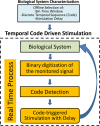Temporal Code-Driven Stimulation: Definition and Application to Electric Fish Signaling
- PMID: 27766078
- PMCID: PMC5052257
- DOI: 10.3389/fninf.2016.00041
Temporal Code-Driven Stimulation: Definition and Application to Electric Fish Signaling
Abstract
Closed-loop activity-dependent stimulation is a powerful methodology to assess information processing in biological systems. In this context, the development of novel protocols, their implementation in bioinformatics toolboxes and their application to different description levels open up a wide range of possibilities in the study of biological systems. We developed a methodology for studying biological signals representing them as temporal sequences of binary events. A specific sequence of these events (code) is chosen to deliver a predefined stimulation in a closed-loop manner. The response to this code-driven stimulation can be used to characterize the system. This methodology was implemented in a real time toolbox and tested in the context of electric fish signaling. We show that while there are codes that evoke a response that cannot be distinguished from a control recording without stimulation, other codes evoke a characteristic distinct response. We also compare the code-driven response to open-loop stimulation. The discussed experiments validate the proposed methodology and the software toolbox.
Keywords: computational biology; electric fish; information theory; neuroinformatics; signal processing.
Figures









Similar articles
-
Recording human electrocorticographic (ECoG) signals for neuroscientific research and real-time functional cortical mapping.J Vis Exp. 2012 Jun 26;(64):3993. doi: 10.3791/3993. J Vis Exp. 2012. PMID: 22782131 Free PMC article.
-
Command-line cellular electrophysiology for conventional and real-time closed-loop experiments.J Neurosci Methods. 2014 Jun 15;230:5-19. doi: 10.1016/j.jneumeth.2014.04.003. Epub 2014 Apr 24. J Neurosci Methods. 2014. PMID: 24769169
-
Delay-Dependent Response in Weakly Electric Fish under Closed-Loop Pulse Stimulation.PLoS One. 2015 Oct 16;10(10):e0141007. doi: 10.1371/journal.pone.0141007. eCollection 2015. PLoS One. 2015. PMID: 26473597 Free PMC article.
-
Electrophysiology-Based Closed Loop Optogenetic Brain Stimulation Devices: Recent Developments and Future Prospects.IEEE Rev Biomed Eng. 2023;16:91-108. doi: 10.1109/RBME.2022.3141369. Epub 2023 Jan 5. IEEE Rev Biomed Eng. 2023. PMID: 34995192 Review.
-
From oscillators to modulators: behavioral and neural control of modulations of the electric organ discharge in the gymnotiform fish, Apteronotus leptorhynchus.J Physiol Paris. 2002 Sep-Dec;96(5-6):459-72. doi: 10.1016/S0928-4257(03)00002-0. J Physiol Paris. 2002. PMID: 14692494 Review.
Cited by
-
Modeling the Sequential Pattern Variability of the Electromotor Command System of Pulse Electric Fish.Front Neuroinform. 2022 Jun 28;16:912654. doi: 10.3389/fninf.2022.912654. eCollection 2022. Front Neuroinform. 2022. PMID: 35836729 Free PMC article.
-
Electric pulse characteristics can enable species recognition in African weakly electric fish species.Sci Rep. 2018 Jul 17;8(1):10799. doi: 10.1038/s41598-018-29132-z. Sci Rep. 2018. PMID: 30018286 Free PMC article.
-
Modulation of neuronal dynamics by sustained and activity-dependent continuous-wave near-infrared laser stimulation.Neurophotonics. 2024 Apr;11(2):024308. doi: 10.1117/1.NPh.11.2.024308. Epub 2024 May 17. Neurophotonics. 2024. PMID: 38764942 Free PMC article.
-
RTHybrid: A Standardized and Open-Source Real-Time Software Model Library for Experimental Neuroscience.Front Neuroinform. 2019 Mar 12;13:11. doi: 10.3389/fninf.2019.00011. eCollection 2019. Front Neuroinform. 2019. PMID: 30914940 Free PMC article.
References
-
- Bell C. C., Myers J. P., Russell C. J. (1974). Electric organ discharge patterns during dominance related behavioral displays ingnathonemus petersii (mormyridae). 92, 201–228. 10.1007/bf00694506 - DOI
LinkOut - more resources
Full Text Sources
Other Literature Sources

